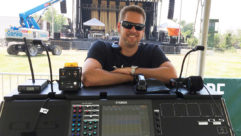
5-Minute Interview: Tom Young
Staff engineer at Altel Systems in Brewster, N.Y., and owner of his own consulting business, Connecticut-based Electroacoustic Design Services. Young spent 10 years as a sound mixer in New York and toured with ?A Chorus Line? in Europe.
Staff engineer at Altel Systems in Brewster, N.Y., and owner of his own consulting business, Connecticut-based Electroacoustic Design Services. Young spent 10 years as a sound mixer in New York and toured with “A Chorus Line” in Europe.
PRO AV: How are the acoustical challenges in houses of worship different from other venues or spaces?
YOUNG: In a traditionally designed house of worship, they won’t allow absorption up where the architecture is a strong element, but the acoustics are not a substantial obstacle for the types of services there. However, when the service adapts to a more contemporary style of worship in the same building, there’s almost always a substantial problem because the instrumentation has no business being in that type of acoustic environment. In the case of new construction, most consultants are called in too late in the design process to affect the key acoustical elements, primarily the shaping of the room. A circular space is the worst possible shape for acoustics.
PRO AV: Spoken communication and music are such critical parts of worship services. Why do so many houses of worship ignore acoustic issues in the design stages of a project?
YOUNG: The members of the design team are often volunteers, people from the congregation, and don’t have any idea about acoustics. They often have full-time jobs and families, or are employed by the church and have full-time ministries, so they don’t have time to learn about acoustics. The design team has to figure out the parking facilities, zoning, funding, and permits, so the sound system is often ignored until the very end.
PRO AV: What are some of the biggest obstacles in sound in these venues?
YOUNG: There are churches that are more advanced, and usually more successful, and so thoroughly invested in technology that the design teams don’t make these mistakes. They also can afford to hire people. But most churches get their staff by volunteerism. They’re players or singers who don’t necessarily have a lot of performance experience, so they play too loud, which is a major problem in contemporary worship styles. With the sound crew, you have somebody that has no real-world experience doing live sound.
PRO AV: What percentage of house of worship projects do you think actually involved an acoustical consultant?
YOUNG: The percentage of new construction of houses of worship that employ an acoustic consultant is probably 20 percent to 30 percent, and that’s a broad statement. Where I am in New England, there aren’t a whole lot of churches being built, and the churches up here don’t rely on sound technology. Down South, they’re more likely to incorporate contemporary worship styles and be aware of sound system and acoustic needs, so I think perhaps that percentage would definitely be higher there.
PRO AV: What’s the best way to increase that percentage?
YOUNG: The only solution is through education. There have been some attempts to inform the architectural schools and degree programs, but reaching out to architects is difficult. The typical architectural student gets about eight hours of classroom instruction on acoustics, but when you think about all the other things they need to learn, I don’t think that’s surprising. The one thing we have going for us is the Internet. Church Soundcheck (www.churchsoundcheck.com) is a very educational resource.










